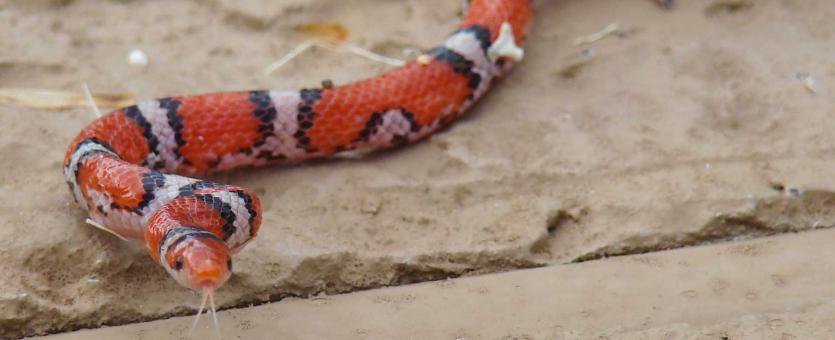
The northern scarletsnake is a small to medium-sized, multicolored snake with a pointed head. It has wide orange or red incomplete bands bordered by narrow black bands over a white or light yellow ground color. On large individuals, there may be some black pigment present in the red bands. The snout is pointed and generally red or orange. A key identifying character of this species is its spotless white or cream-colored belly. The dorsal (upperside) scales are smooth.
In Missouri, this species is extremely rare to find, with a patchy distribution.
Similar species:
- The eastern milksnake (Lampropeltis triangulum) looks similar, but it is more common in our state and occurs nearly statewide. Its snout is usually not orange or red, and it has bold black markings on its white belly (its belly is not spotless and white).
- The variable groundsnake (Sonora semiannulata semiannulata) is a smaller species (usually only to about 12 inches long) with a highly variable coloration; some individuals can be orange or red with black crossbands; the belly is white or cream-colored, with the tail underside having dark crossbars.
- Some people become alarmed any time they see a snake that is red, yellow, and black, because they have heard of venomous coral snakes. Coral snakes, however, do not occur in Missouri.
Adult total length: 14¼ to 20 inches; occasionally to 32½ inches.

There are scattered records in central, southwest, and southeastern parts of the state.
Habitat and Conservation
The scarletsnake is secretive and spends much of its time underground, except on warm nights or after heavy summer rains. In Missouri, its habitat varies from mixed hardwood-pine woodlands to sand prairie grasslands and savannas. The few specimens taken in central and southwestern Missouri were found on wooded, rocky hillsides. More recently, numerous individuals have been found in the sandy and loamy soils in southeastern Missouri.
Scarletsnakes live under flat rocks, logs, leaves, or other objects. This snake can quickly burrow into the sandy substrate by thrusting its head and neck back and forth until concealed beneath the loose soil. The active season is probably April into October. Most individuals are seen in July.
Scarletsnakes rarely if ever bite when handled.
Food
Scarletsnakes mostly eat the eggs of turtles, lizards, and other snakes; they may swallow the eggs whole or break the eggshell with their teeth and then swallow the contents. The rear teeth are large and sharp and aid in slitting eggshells. This species may occasionally eat lizards, small snakes, and mice, killing the prey by constriction.
Status
Rare; a Missouri species of conservation concern, classified as imperiled or vulnerable in our state.
Because so few of these snakes have been found in Missouri, it is difficult to determine their conservation status. The scattered records found in most of the Ozarks are old reports from before the 1970s. However, there have been numerous individuals found since 2010 in the sand prairie and savanna areas of southeastern Missouri. They may be more common than we think. Because of their secretive nature, they are rarely encountered, so it's hard to tell.
The overall range of this species includes much of the southeastern United States. Numerous disjunct populations are known throughout the northern part of their range, and Missouri appears to be part of this pattern.
Life Cycle
Little is known about the reproduction of this species. Apparently, mating occurs in the spring, and the eggs are probably laid during June and July, with females producing 2–9 eggs. The female deposits the eggs in underground burrows, under rocks, or under plant material. The eggs apparently hatch in September. Scarletsnakes apparently become sexually mature at two to three years of age.
Human Connections
Snakes have always captured the imaginations of humans. In myth, religion, and story, snakes perform the role of seducer, sneak, guardian, healer, killer, and transformer.
Even though seldom seen, this attractive, harmless snake is part of the natural wealth of our state.
Although it is a colorful snake, its specialized diet of reptile eggs and its inclination to remain hidden makes this snake a poor pet. Also, its rarity and possible vulnerability to extirpation mean that it's a bad choice to remove any of them from nature.
Ecosystem Connections
As predators, scarletsnakes control populations of other reptiles by consuming their eggs. As with many other predatory species, they are preyed upon themselves by many larger animals, including snakes, mammals, and birds. The eggs and young are especially vulnerable.
Sand prairies and savannas, where several scarletsnakes have been seen most recently in Missouri, are critically imperiled habitats in our state. Conservationists are restoring some of these unique landscapes, which supports not only these beautiful snakes but also many beautiful wildflowers, birds, and other species that require these lands.

























